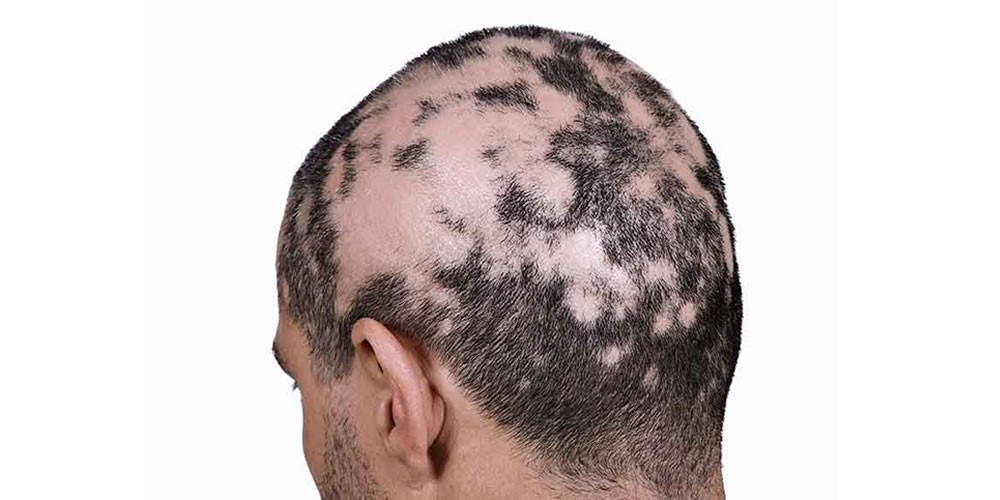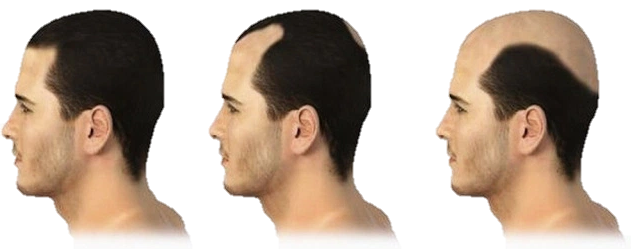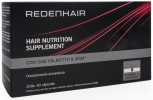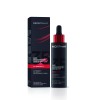Nowadays, many people are already familiar with the term "alopecia", the condition that causes abnormal hair loss and may affect the scalp or other areas of the skin on which there is hair, such as eyelids, eyebrows, underarms, the genital area and beard. "Alopecia" is the Latin word for hair loss, and the term covers a wide variety of conditions.
Hair grows all over the human skin, except on the palms of our hands and the soles of our feet, but many of these hairs are so thin that they are virtually invisible. Keratin is the structural protein of the hair and is produced in the hair follicles of the outer layer of the skin. As the follicles produce new ciliated cells, the old cells are expelled through the surface of the skin at a speed of approximately 15 centimetres per year. Hair is, actually, no more than a fine thread of dead keratin cells. The head of the average adult has between 100,000 and 150,000 hairs and loses up to 100 of them each day.
Alopecia areata
Alopecia areata is a form of non-scarring hair loss that generally develops as localised bald spots on the scalp and is an autoimmune disease that causes the body’s own immune system to attack healthy hair follicles. Once hair has been lost from these areas, new growth slows down for weeks or months. The exact causes of this condition are still unknown, but they are believed to be triggered by stress and traumatic events, affecting people with other types of autoimmune diseases, such as thyroid conditions, lupus, pernicious anaemia or allergies. In certain cases, it can cause complete scalp baldness (total alopecia) or total body hair loss.
Treatment for alopecia areata

There is currently no curative treatment against alopecia areata. However, there are topical treatments that in many cases can slow down hair loss and make hair grow again. Making the hair grow is just as important as subsequently maintaining it, which is usually the hardest part of the treatment, as relapses are common.
From a pharmacological perspective, anti-inflammatory drugs are commonly used to act on the autoimmune mechanism. This group includes lotions with corticosteroids and local infiltrations with micro-injections, which serve to control the growth on small areas of the scalp. It can be slightly painful, but is well tolerated and is fast to perform. This is an excellent alternative to keep the condition under control when small areas of alopecia reappear after the reduction or discontinuation of the oral medication.
When the symptoms require it, oral corticosteroids can be prescribed. This means that the treatment can be administered comfortably (only two doses each week) and prevents the onset of the most common adverse effects associated with daily administration of corticosteroids to a great extent.
Androgenetic alopecia

Androgenetic alopecia is scientific term for genetic hair loss, be it either male-pattern hair loss or female-pattern hair loss. It is the most common type of hair loss and affects everyone at some point in their lives, sometimes prematurely during adolescence or in their early twenties, and sometimes at a later age.
This condition arises when the enzymes in the body start converting the hormone testosterone into its derivative, dihydrotestosterone (DHT), which reduces the size of hair follicles. The tendency for androgenetic alopecia can be transmitted genetically by either the mother or the father.
Treatment for androgenetic alopecia
In any of the stages, the most important part is the diagnosis, which serves to confirm that the issue is in fact male-pattern androgenetic alopecia. Once the presence of this condition is confirmed, it is essential to know its current stage or phase.
In the first phase, when the loss of hair, volume and density starts to be noticeable, along with thinner spots of hair on the scalp, the aim is to both to slow down the hair loss and to promote growth in the area, making new and higher-quality (thicker, denser) hair grow. In these cases, we recommend using HAIR REGENERATOR SERUM FORTE and HAIR REGENERATOR SERUM MAINTENANCE. Both products are formulated based on a potent mixture of active ingredients with specific actions that inhibit the enzyme that serves as a catalyst for the formation of DHT in order to repopulate the scalp and stimulate healthy and strong hair growth.


Traction alopecia
Traction refers to the internal stress to which a body is subjected due to the application of two forces acting in opposite directions and stretching it. Having said this, traction alopecia develops when the hair is pulled tight for a long time. If this action is performed repeatedly, it ends up loosening the hair from its corresponding hair follicle.
Some of the causes are, for instance, pulling the hair back with a ponytail or bun, braids or dreadlocks on a regular basis, using hair extensions, using curlers at night, wearing your hair too long, etc.
This type of hair loss is very common in African American women, although it can affect people of any ethnic origin. It is most common among professionals who tend to pull their hair back into tight hairstyles, such as dancers and gymnasts. Although traction alopecia can affect people of any age, it is more likely to happen as we get older, since the hair becomes more damaged the longer it has been stretched.
Treatment for traction alopecia

The main treatment for traction alopecia is to change your hairstyle and the practices that go with it. The recommendations for preventing this type of hair loss are essential if you wish to reverse the process.
It is also advisable to use natural products that help regenerate the follicles and boost their development. At REDENHAIR we have a range of products designed to stimulate healthy hair growth in the most natural way, with clinical studies that support the effectiveness of all their active ingredients. If this condition has already affected you significantly, now is the time to take action and start improving the health of your hair. With the REGENERATIVE TREATMENT KIT by REDENHAIR you will ensure that your hair recovers its original health and stimulate healthy and uniform growth again.
You can also purchase any of the products individually:

Telogen effluvium

Telogen effluvium is deemed to be the second most common cause of hair loss diagnosed by dermatologists. It takes place when there is a significant change in the amount of growing hair follicles. If this number decreases significantly during the resting phase of hair growth, more latent hair follicles appear, which results in a significant, but generally not permanent, hair loss.
This type of hair loss is temporary and occurs after all kinds of stressful situations, traumatic events or shock. It is important to differentiate between telogen effluvium and the permanent hair loss disorder, known as alopecia areata. Although large amounts of hair might be lost, telogen effluvium is usually temporary and, if treated properly, the hair will grow normally again afterwards.
At any given moment, around 90% of the hairs on someone's head are growing actively (anagen phase) while the others are resting (telogen phase). Usually, hair remains in the anagen phase for two to four years, then enters the telogen phase, rests for about two to four months and is finally shed and replaced by new, growing hair. A person naturally loses around 100 hairs a day on average.
Treatment for telogen effluvium
It is important to find out whether it is actually telogen effluvium that is causing the hair loss. If so, the treatments for telogen effluvium range from lifestyle changes to treatments containing natural products for topical application, such as REDENHAIR, that help prolong the anagen (active growth) phase of the hair follicles.
Additionally, some of the causes of this disorder can be corrected. For instance, if your diet is deficient, try the REDENHAIR HAIR NUTRITION SUPPLEMENT capsules or try to maintain a diet rich in nutrients such as zinc and copper. Similarly, if the hair loss was triggered after starting a new medical treatment, ask your doctor about the medication's possible side effects.
Although losing a lot of hair in a short time can be terrifying, this disorder is usually temporary. Each hair that is prematurely pushed into the telogen phase is replaced by a new hair in growth, so there is no risk of complete baldness if the appropriate actions are taken. Most cases last for six to nine months and the hair usually starts to grow again. If you want to gain volume quickly to conceal this temporary condition, the ideal product is a hair thickener.
REDENHAIR's HAIR THICKENER is a 100% natural and instant solution that gives density and volume to your hair and conceals telogen effluvium. These keratin hair fibres instantly add thickness and density to each hair and are completely undetectable.

Diffuse alopecia
Diffuse alopecia is gradual and generalised hair loss that does not result in total baldness. In this specific case, the hair starts looking limp and lifeless, as well as scarcer.
This type of alopecia can develop, among other reasons, due to endocrine disorders, medicinal products or bad nutrition. In the first case, it is a symptom of problems in the endocrine glands, such as hyperthyroidism or hypothyroidism, conditions that usually cause diffuse hair loss. Medicinal products can also affect diffuse hair loss and hair thinning; some examples are anticoagulants, chemotherapy treatments, psychiatric drugs, oral contraceptives and excess vitamin A, among others. Nutrition is also very important for hair health and to prevent diffuse alopecia. If the hair does not have the nutrients required for its development, it becomes dry, fragile and thinner. The hair roots develop cracks and start breaking easily, and the black hairs become more red.
In the same manner, some conditions associated with nutritional problems also affect the health of your hair; one example is anorexia nervosa, which weakens the hair and ultimately causes hair loss. Mainly, iron and zinc deficiencies are the ones that cause diffuse hair loss.
Treatment for diffuse alopecia

Diffuse alopecia can be prevented and treated. One of the key approaches is to follow a balanced diet so that the hair obtains all the nutrients it needs to remain healthy. As soon as any symptom arises that suggests you might be suffering from this type of alopecia, visit a specialist to have an analysis performed. With a diagnosis, you will be able to start a treatment as soon as possible and put an end to your hair loss. It is also possible to regrow lost hair. There are many treatments, but not all of them are appropriate for everyone. REDENHAIR HAIR NUTRITION SUPPLEMENT is the ideal supplement to prevent deficiencies of these important nutrients in your body. It is a dietary supplement that reinforces the hair follicles for healthy and strong growth.

Total alopecia

This is an autoimmune disease that results in total hair loss, but only on the scalp. This condition is an intermediate point between alopecia areata and alopecia universalis.
There are generally two common types of total alopecia: the first one entails a fairly fast and complete loss of hair from the head. The second type is slower and starts as patchy hair loss, like in alopecia areata, and evolves to the point of complete hair loss from the scalp.
Alopecia universalis

The most advanced type of alopecia, described as complete hair loss affecting the whole body. Given that an absence of hair on the skin exposes areas such as the nasal cavities, eyes and scalp to all kinds of risks, it is very important for people with this condition to take great care in protecting themselves against bacteria, sunlight and other extremely dangerous agents.
This type of alopecia is an advanced form of alopecia areata. Although its exact cause is unknown, it is believed to be an autoimmune condition in which the immune system of the person attacks the hair follicles by mistake. The interaction between genetic and environmental factors plays a key role in the onset of this condition. There is currently no cure for this type of alopecia, but sometimes hair starts growing again on its own, even after many years.


 GREYVERSE™, ACTIVE PRINCIPLE OF REDENHAIR ANTI-GREYING RITUAL
GREYVERSE™, ACTIVE PRINCIPLE OF REDENHAIR ANTI-GREYING RITUAL
 Myths about hair fibers Are they harmful to our hair?
Myths about hair fibers Are they harmful to our hair?
 MANY CELEBRITIES ALREADY USE OUR LASER HELMET (LLLT)
MANY CELEBRITIES ALREADY USE OUR LASER HELMET (LLLT)
 REDENHAIR REGENERATING BRUSH VS REDENHAIR REGENERATING HELMET
REDENHAIR REGENERATING BRUSH VS REDENHAIR REGENERATING HELMET
 ENJOY THE BENEFITS OF COLLAGEN WITH REDENHAIR
ENJOY THE BENEFITS OF COLLAGEN WITH REDENHAIR
 SANDALWOOD, ALLY IN THE FIGHT AGAINST ALOPECIA
SANDALWOOD, ALLY IN THE FIGHT AGAINST ALOPECIA
 THE PHASES OF A HAIR TRANSPLANT AND THE ALTERNATIVE REDENHAIR OFFERS YOU
THE PHASES OF A HAIR TRANSPLANT AND THE ALTERNATIVE REDENHAIR OFFERS YOU
 WHAT IS FEMALE ALOPECIA FOR AGING AND HOW TO TREAT IT?
WHAT IS FEMALE ALOPECIA FOR AGING AND HOW TO TREAT IT?
 LATEST TECHNOLOGY FOR HAIR BASED ON LASER LIGHT
LATEST TECHNOLOGY FOR HAIR BASED ON LASER LIGHT
 Saltpeter and hair
Saltpeter and hair
 What is dandruff? What types of dandruff are there?
What is dandruff? What types of dandruff are there?
 At what age can we start using anti-hair loss products?
At what age can we start using anti-hair loss products?







